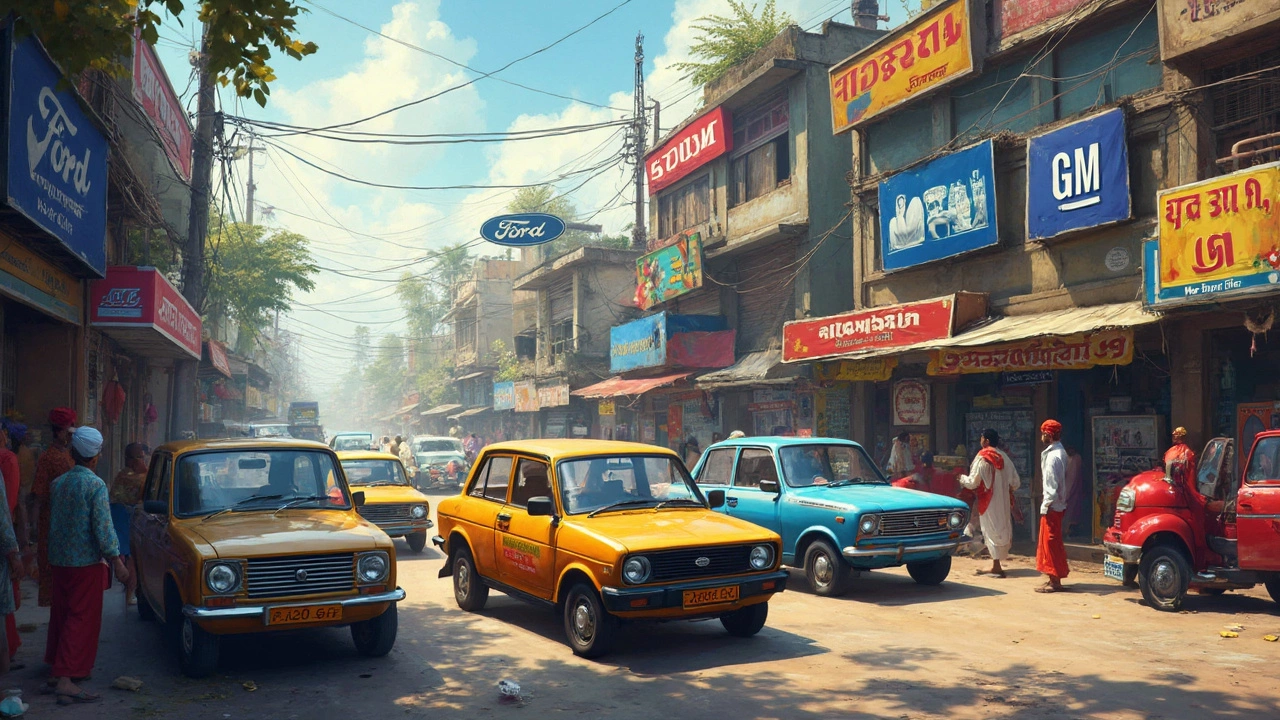Picture this: global automotive giants ready to take on a burgeoning market, dreams of their sleek rides zipping through India's busy streets. Well, that's how it started for Ford and GM in the 1990s. But fast forward a few decades, and the glamor turned into an aftermath of closed factories and disappointed partners. So what made these auto titans stumble in India? Let’s break it down.
First off, Ford and GM's grand entrance into India came with lots of ambitions. They planned to tap into the growing middle class, which sounded great. Who wouldn't want a slice of that pie? But here's the catch: they misunderstood the Indian consumer. Imagine trying to sell snow blowers in the middle of a desert—kind of like that. Indians wanted affordable, fuel-efficient cars. Meanwhile, Ford and GM were busy pushing bigger, pricier models that didn’t vibe with what the majority wanted.
And then there was the roaring competition. Local brands like Tata and Mahindra weren’t just sitting ducks—they were evolving fast. These homegrown companies offered what Indians truly wanted and understood the market subtleties better than outsiders. The edge was real.
- Initial High Hopes and Promising Entry
- Understanding the Indian Consumer
- Competition from Local Automakers
- Economic Hurdles and Policy Challenges
- Lessons Learned for Future Endeavors
Initial High Hopes and Promising Entry
Back in the '90s, the idea of entering the Indian market seemed like a total no-brainer for big names like Ford and GM. The economy was opening up, and these car makers envisioned their sleek models dominating the streets amidst an ever-growing middle class. To them, India looked like a land of endless opportunity.
Ford launched modestly in 1995 by rolling out the Ford Escort, tapping into middle-ground, affordable luxury that was new and exciting for Indian customers. Similarly, GM, through a joint venture, started selling the Opel brand in the same year, hoping to capture the attention of those seeking stylish yet reliable options.
The excitement wasn't limited to the business side. Local consumers were eager too, with many curious to see what these global brands had to offer. After all, the thought of having new car choices sure was appealing when local options felt a bit worn out.
Ford and GM didn't just jump in without a strategy. They both made substantial investments in manufacturing facilities, eyeing long-term growth. GM set up a plant in Gujarat, while Ford chose to establish itself in Chennai, which was already shaping up as a car manufacturing hub.
There was also a buoyant demand for mid-range cars, which Ford and GM hoped to capitalize on. The local market dynamics were compelling, with a youthful population and increasing urbanization that meant more potential drivers every year.
But despite these promising beginnings, things didn’t follow the script. While initial sales figures looked rosy, with Ford’s Mondeo attracting attention and GM’s Opel Astra gaining a modest fanbase, hurdles soon loomed on the horizon that neither company had fully anticipated. Yet, in the spirit of optimism, both companies hoped their strong global presence and expertise would eventually steer them past these challenges.
Understanding the Indian Consumer
Alright, let's get real about what went wrong for Ford in India and GM. The Indian consumer is a tough cookie, and these car giants just didn't get them. So, what's so unique about buyers in India? It's all about value for money, mileage, and practicality more than flashy features.
India's love affair with small, fuel-efficient cars isn't a secret. With congested cities and rising fuel prices, compact cars that don't guzzle gas are the day’s heroes. Major brands like Maruti Suzuki hit the jackpot by focusing on these affordable, practical rides that cater to first-time buyers and middle-class families.
Then there's the whole 'car as a status symbol' thing. Yes, cars are seen as a sign of success here, but not in the way you might think. People crave reliability, low maintenance costs, and resale value. Models from Ford and GM tended to run higher in terms of ongoing costs, making cheaper, local alternatives more enticing.
Moreover, the after-sales service landscape is crucial. Indian consumers expect solid service and quick turnaround for repairs. Local players had a vast network of service centers all over, while Ford and GM struggled to match that reach and customer assurance.
| Factor | Importance to Indian Consumers |
|---|---|
| Fuel Efficiency | High |
| Maintenance Costs | Low |
| Price | Critical |
| After-Sales Service | Very Important |
Clearly, the market demanded something different from what Ford and GM offered. As the economy grew, so did the customer's desire for what resonates culturally and financially. These companies ignored an essential rule of thumb: Know your audience.

Competition from Local Automakers
Now, let's talk about the fierce rivals Ford and GM faced in India. Local automakers like Tata Motors and Mahindra were no small fry. These companies were not just surviving; they were thriving by understanding exactly what Indian consumers needed. Imagine knowing the secret spot in a crowded bazaar where everyone wants to shop—that’s the edge these local giants had over the big American players.
Tata Motors made a massive impact with models like the Tata Nano—touted as the world’s cheapest car. For a country where many people wanted affordable and fuel-efficient rides, this was a game-changer. Tata wasn’t just selling a car; they were selling a dream of car ownership to millions of Indians who found typical Ford and GM models out of reach.
Meanwhile, Mahindra & Mahindra focused on rugged SUVs and commercial vehicles, perfectly suited for India's diverse terrain. They tapped into a demand Ford and GM hadn’t fully grasped. An interesting fact: Mahindra's vehicles often felt relatable because they were rooted in local knowledge and crafted for the everyday Indian, unlike some of the pricier foreign models.
Adding to the mix, these local companies enjoyed a home-ground advantage. They were more in sync with the government policies and went an extra mile to meet regulatory norms. Plus, they had the cost game figured out. Lower production costs meant they could offer competitive pricing, something Ford and GM struggled with due to higher manufacturing and import costs.
Let’s not forget Maruti Suzuki’s dominance. While technically a Japanese-Indian joint venture, they knew how to play the field with reliable, budget-friendly cars. When new players entered the market, they didn’t just face competition from Maruti’s models but also fought against the brand loyalty that had built up over decades.
- Ford and GM’s larger vehicles couldn’t compete with compact, economical Indian models.
- Local brands were deeply aware of what Indian roads and consumers needed.
- Pricing strategies of local players were aggressive and effective.
All said, the Indian auto market wasn’t about bringing a flashy foreign car and expecting buyers to flock. It was a complex dance of understanding local tastes, offering value, and providing what people genuinely needed—all things local automakers excelled at while Ford and GM fell short.
Economic Hurdles and Policy Challenges
Diving into Ford and GM's exit from India, a big chunk of the puzzle is economic challenges and policy twists. India isn’t just another stop on the global map; it’s a complex market with its own unique hurdles. Let’s unravel some of these issues that created turbulence for these automotive giants.
First off, taxes were a major sore spot. India’s tax structure is no walk in the park. Cars were hit with high import duties, which jacked up prices for Ford and GM models. Compounded by Goods and Services Tax (GST) rates, vehicles from foreign makers suddenly seemed out of reach, especially when local brands could offer cheaper options.
Then comes the notorious bureaucracy and changing regulations. The auto industry here saw shifts in emission norms and safety standards. While these are crucial for sustainable growth, Ford and GM found it costly to adapt, given the extensive re-engineering required to meet the new rules. Some felt like they were running to catch a moving train, even before the engine had properly started.
The dramatic swings in the Indian rupee didn’t help either. Currency fluctuations added another layer of complexity, impacting imports and operation costs. Imagine doing your grocery shopping and waking up to find prices doubled overnight - not the kind of surprise you want when running a business.
Here's a quick snapshot of the impact of these changes:
| Factor | Impact on Foreign Automakers |
|---|---|
| High Import Duties | Increased vehicle costs |
| Regulatory Changes | Raised compliance expenses |
| Currency Fluctuations | Unpredictable operation costs |
Lastly, investing in India comes with infrastructure challenges. There were supply chain hiccups and quality control issues. Not having a robust local manufacturing base put Ford and GM at a disadvantage, especially when compared to seasoned local players who sidestepped these pitfalls with ease.
So while the road ahead for international ventures in India is paved with opportunities, avoiding these common potholes involves understanding and navigating the economic and policy landscapes with precision. It’s a lesson in adapting rapidly and maybe learning a trick or two from local competitors.

Lessons Learned for Future Endeavors
So, after watching Ford and GM navigate the rough roads of the Indian market, what can other carmakers learn from their experience? There are key takeaways that can be real game-changers for those eyeing India.
First, understanding the local audience is everything. Ford and GM's error was thinking what worked globally would fit in India without tweaks. Nope, that didn't cut it. Future players need to dive deep into what Indian consumers want. Think about the almost obsessive desire for mileage and affordability. A car could be all glitter and chrome, but if it guzzles gasoline, Indians might just swipe left.
The competition here is fierce. Companies like Tata and Mahindra know their customers well and aren’t shy about delivering top value for money. Any new entrant should be ready for a tough fight. Innovate beyond technology; look into after-sales service, customer engagement, and local partnerships. And yes, having a local manufacturing presence can cut costs and turn you into a serious contender.
Speaking of local presence, there's a lot to say about understanding economic policies and regulations. India loves its roadchecks and tax rules, which can be a maze for unsuspecting businesses. Proper groundwork into government policies can avoid costly missteps down the line.
Collaborations and joint ventures could be the secret sauce. Consider that some of the most successful foreign brands in India teamed up with local entities to fine-tune their market strategies. Tapping into local expertise can offer insights that satellite operations can't match.
As a cherry on top of these lessons, let’s toss in some data. Here's a simple representation:
| Year | Car Sales in India (millions) | Local Brand Sales Share (%) |
|---|---|---|
| 2020 | 2.5 | 60 |
| 2022 | 2.8 | 62 |
| 2024 | 3.1 | 65 |
See those numbers? They're proof that the local brands are steadily gaining traction. So for any newbie in India’s auto scene, adapting is not just smart—it's crucial. Doing the homework can make all the difference between seeing a flagship model zipping through the street versus collecting dust in a showroom corner.






